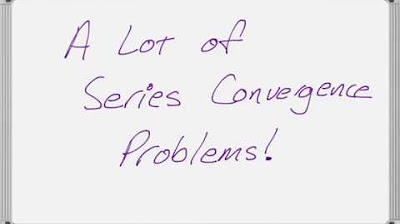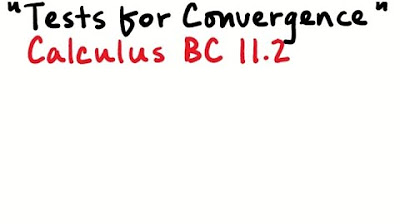Avon High School - AP Calculus BC - Topic 10.8 - Example 3 - Parts a,b, and c
TLDRIn this engaging lecture, Mr. Record guides students through the intricacies of infinite series, emphasizing the importance of understanding their behavior. He advises on strategies for testing series convergence, highlighting the need to recognize special patterns and apply the most suitable test, whether it's the nth term test, comparison, or integral test. By working through examples, he illustrates how different tests can be applied, even when they're mixed, and encourages students to practice in varied environments to enhance their problem-solving skills.
Takeaways
- 📚 The class is concluding the study of convergence and divergence of infinite series, focusing on the tail end of topic 10.8.
- 🎯 Students are encouraged to practice problem-solving in an environment where different tests could apply to a single series, enhancing their understanding and application skills.
- 🧠 The instructor emphasizes the importance of recognizing the 'special look' of a series to determine which test might be applicable.
- 📈 Among the 10+ tests studied, only 8 will be tested on the AP Calculus exam, excluding the telescoping and polynomial tests.
- 🛠️ A strategy for testing series is suggested: look for special features, apply the nth term test for divergence, and then move to trickier tests if necessary.
- 📊 The integral, ratio, and root tests are commonly used, but the choice depends on the appearance of the series and personal preference for simplicity and productivity.
- 🌟 The instructor provides handouts and resources, like a convergence flow chart and a foldable guide, to aid students in determining the convergence of series.
- 🔢 Example A (sum of (n+1)/ (3n+1)) demonstrates the use of the nth term test for divergence, leading to the conclusion that the series diverges.
- 🔄 Example B (sum of 1/ (r(2n-1))) showcases the identification of a geometric series and its convergence based on the value of the common ratio.
- 🧬 Example C (sum of n * e^(-n^2)) illustrates the application of the ratio test, which can sometimes be more efficient than the integral test, especially for this particular series.
Q & A
What is the main topic being discussed in the transcript?
-The main topic discussed in the transcript is the convergence and divergence of infinite series, specifically focusing on the tail end of topic 10.8 in an AP Calculus BC class.
What does the speaker emphasize about the complexity of mixed practice problems in series?
-The speaker emphasizes that practicing with mixed problems where different tests could apply is crucial for understanding the behavior of series, as it is a different challenge compared to working on problems that clearly indicate the use of a specific test.
Which series tests are not included in the AP Calculus exam?
-The telescoping series test and the polynomial test are not included in the AP Calculus exam.
What is the speaker's suggested strategy for approaching a series test?
-The speaker suggests first identifying if the series has a special form that would apply a specific test, then exhausting the simpler tests like the nth term test for divergence, and finally moving on to trickier tests like the integral or comparison tests.
How does the speaker determine the convergence of the series in part b?
-The speaker determines the convergence of the series in part b by recognizing it as a geometric series and verifying that the absolute value of the common ratio (r) is less than 1.
What is the significance of the limit of 1/3 in part a of the example?
-The limit of 1/3 in part a indicates that the series diverges because it is not equal to zero, which would be the case for a convergent series according to the nth term test for divergence.
Why does the speaker choose the ratio test over the integral test for the series in part c?
-The speaker chooses the ratio test over the integral test for part c because it is quicker and does not require showing the three criteria for the integral test's applicability, which would be necessary if using the integral test.
What is the result of the ratio test for the series in part c?
-The result of the ratio test for the series in part c shows that the series converges, as the limit calculated is less than one.
What is the role of the nth term test in the speaker's strategy?
-The nth term test plays a role in the speaker's strategy as an initial check for divergence. If the limit of the nth term does not equal zero, the series is considered to diverge.
How does the speaker approach the comparison of different tests for a series?
-The speaker approaches the comparison by first trying the simpler and more straightforward tests, and only resorts to more complex tests like comparison or integral tests if the simpler ones do not apply or are less efficient.
What is the significance of the integral test's three criteria mentioned in the transcript?
-The three criteria for the integral test's applicability are that the function must be positive, continuous, and decreasing over a certain interval to infinity. These criteria are necessary to establish that the integral test can be used to determine convergence.
Outlines
📚 Introduction to Series Convergence and Divergence
The speaker, Mr. Record, introduces the topic of the tail end of 10.8, which focuses on the convergence and divergence of infinite series. He emphasizes the importance of understanding the behavior of series, especially when different tests are mixed together. He advises students on strategies for testing series, suggesting that the first step is to identify any special characteristics of the series that might indicate which test to apply. He mentions that while 10 different tests are studied, only eight will be tested on the AP Calculus exam, excluding the telescoping and polynomial tests. Mr. Record encourages students to practice with a variety of tests to improve their problem-solving skills.
🔍 Analyzing Series: Strategies and Tests
In this paragraph, Mr. Record discusses various strategies for determining the convergence or divergence of series. He suggests starting with the simplest tests, such as geometric or p-series, and then moving on to more complex tests like the integral test or comparison tests. He provides a detailed example of a series (n + 1 / (3n + 1)) and explains why the nth term test for divergence is applicable. He also touches on the possibility of using different tests for the same series and encourages students to find the most efficient method for them.
🧠 Complex Ratio Test Application
Mr. Record presents a complex example of a series (n * e^(-n^2)) and explains why the integral test might initially seem applicable. However, he chooses to apply the ratio test instead, providing a step-by-step breakdown of the process. He emphasizes the importance of simplifying the expression to find the limit, which ultimately shows that the series converges. The speaker concludes by highlighting that while the integral test might be a common choice, the ratio test can sometimes be quicker and more efficient.
Mindmap
Keywords
💡Convergence and Divergence
💡Infinite Series
💡Integral Test
💡Comparison Test
💡Geometric Series
💡nth Term Test for Divergence
💡Telescoping Series
💡Polynomial Tests
💡Root Test
💡Ratio Test
💡Mark Corelli's Foldable
Highlights
Introduction to the topic of convergence and divergence of infinite series.
Emphasis on the importance of understanding the behavior of series.
Discussion on the different types of series tests, including the integral test and comparison test.
Explanation of the AP Calculus exam's focus on eight specific tests, excluding the polynomial test.
Strategy for approaching series tests, starting with the most recognizable patterns.
Use of the nth term test for divergence as a starting point for series analysis.
Application of the geometric series test and its criteria for convergence.
Discussion on the flexibility of using different tests for a single series problem.
Example of a series that could be analyzed using the integral test due to its integrable nature.
Comparison of the integral test and the ratio test for a specific series.
Detailed explanation of the ratio test and its application to a complex series.
Conclusion that the ratio test can be quicker than the integral test for certain series.
Introduction of additional resources for students, such as handouts and foldable for series convergence.
Encouragement for students to practice with mixed series tests to improve their problem-solving skills.
Upcoming review of parts d, e, and f in the next video to continue the discussion on series convergence tests.
Transcripts
Browse More Related Video

A Lot of Series Test Practice Problems

Infinite Series Multiple Choice Practice for Calc BC (Part 5)

Monday Night Calculus: Strategy for testing series

Infinite Series Multiple Choice Practice for Calc BC (Part 6)

Calculus 2 - Geometric Series, P-Series, Ratio Test, Root Test, Alternating Series, Integral Test

Tests for Convergence
5.0 / 5 (0 votes)
Thanks for rating: